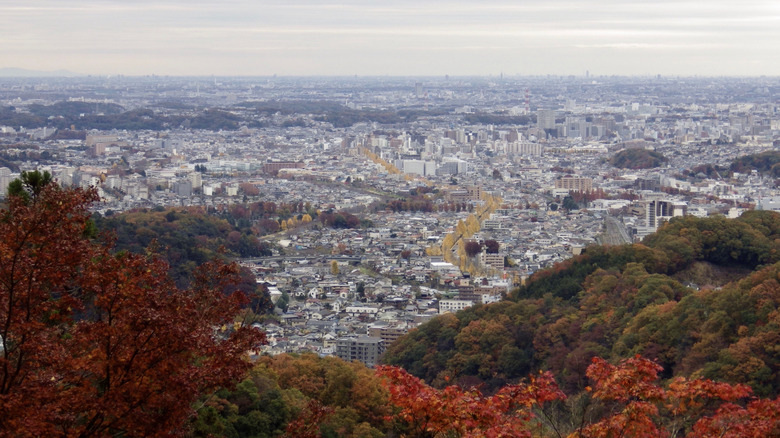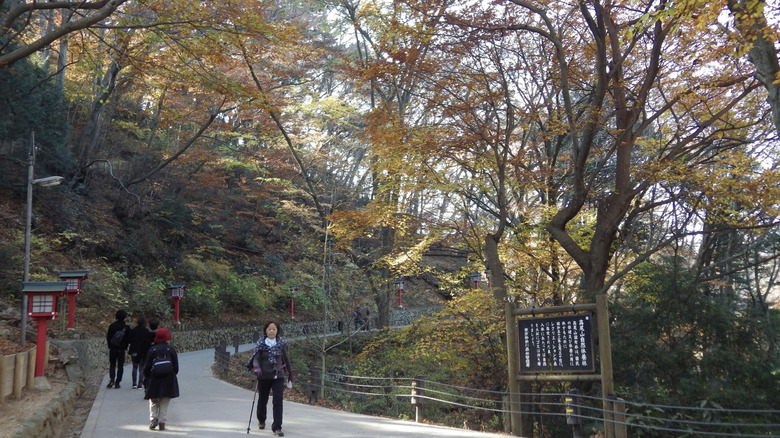The Most Popular Mountain In Tokyo Offers Various Hiking Trails With Scenic Views
When you visualize the world's most populated city, you might not picture green mountains, but there are plenty of those on Tokyo's scenic western outskirts. The most popular one is undoubtedly Mount Takao (in Japanese, Takao-san), which receives up to 4 million visitors per year, according to The Asahi Shimbun. Seasonal beauty, coupled with the relative ease of reaching and summiting Mount Takao, makes it a go-to destination for locals and tourists alike. The 1,965-foot mountain is conveniently located on one end of the branching Keio Line, which has its other terminus in Shinjuku, the world's busiest train station.
In spring, cherry blossoms bloom outside the station for Japan's steepest cable car on Mount Takao. In early summer, hydrangeas bloom along the mountain's trails, while autumn brings out the red maple leaves and other fall colors. Winter yields occasional light snow and the "Diamond Fuji" phenomenon, where you could see the sun setting right behind Mount Fuji from Takao-san's summit, weather permitting.
Having climbed all of Mount Takao and part of Mount Fuji (which stands much higher at 12,388 feet), I can safely say that the former is a walk in the park compared to the latter. That's not just a figure of speech, since Mount Takao has a monkey park you can visit, of all things. It's along Trail 1, the main route for hiking the mountain from bottom to top. This trail is mostly paved, and it usually takes me two hours to ascend it if I'm stopping to snap pictures and snack on dango (skewered rice dumplings) or soba noodles. However, it might only take you 100 minutes, and you could do it in half the time if you ride the cable car or chair lift.
Explore Mount Takao's eight hiking trails
Trail 1 does have a steep curve at one point, but nearby, there's also a lookout called Konpiradai where you can stop for a rest. The view extends all the way from the western suburb of Hachioji, where Mount Takao stands, to the east side of the city, where the distant sliver of Tokyo Skytree towers over the urban sprawl. Halfway up the mountain, near the monkey park and cable car station, you'll have a more panoramic view from the observation deck and seasonal beer garden. Trail 2 loops around the park and its wild plant garden, with Trail 3 veering off on a forest path to the top of Mount Takao.
The highlight of Trail 4 is a suspension bridge surrounded by greenery, whereas Trail 5 circles the summit. Back on Trail 1, there's a fork in the road where you can take the leisurely Onna-zaka (women's slope) or the 108 steps of the Otoko-zaka (men's slope) to the Buddhist temple, Yakuo-in. Passing through the temple gate, you'll see statues of two long-nosed goblins, the tengu. Legend has it these goblins blazed the mountain's trails, with the landmark takosugi (octopus cedar) curling its tentacle-like roots back to avoid them.
Trail 6 is more rugged and challenging, and it leads to a sacred waterfall, Biwa-taki, which could be anticlimactic since it's just a small run-off that's closed to anyone but religious ascetics. Beyond the numbered trails, you can hike to another mountain on the Takao-Jimba Trail, or follow the winding Inariyama Trail, which is said to be the most difficult one on Mount Takao. We've only taken it down the mountain, but many of the hikers we passed who were on their way up were huffing and puffing.
Weekends bring crowds but also more convenient access
Time Out Tokyo once cited Takao-san as the world's most-visited mountain. It certainly feels that way on a public holiday in late November, when you're liable to see a long line of leaf peepers stretching up the mountain. To avoid the worst foot traffic on the trails (and on the summit, which gets congested with picnickers), it's arguably best to visit Mount Takao on a weekday. This is coming from a Tokyoite who's lived along the Keio Line for over a decade. While writing this, I literally received an email invite from another local who was organizing a group to hike Mount Takao on a Monday, when crowds would be lighter.
If you're coming from the city, the one benefit of heading to the mountain on a weekend or holiday is that you can ride one of the special Takao Liner trains that Keio operates. These trains, which require the purchase of reserved seats from a ticket machine, run non-stop to Takaosanguchi in just 45 minutes from Shinjuku and Meidaimae (the transfer point for Shibuya, another major city center). Takaosanguchi is the station closest to the mountain; its name means "Mount Takao exit" in Japanese.
If you're riding one of the Keio Line's non-reserved, semi-express trains, just be careful that you don't board the wrong one. The line can be confusing for first-time Tokyo visitors, since it splits and goes off in different directions in Chofu and Kitano. It technically becomes the Takao Line in Kitano when you're bound for Takaosanguchi, but the trains on the "Keio Line" platform actually alternate between there and Keio-hachioji. You can still reach Takaosanguchi on a Keio-hachioji train, but you'll need to transfer in Kitano before you reach the last stop.


